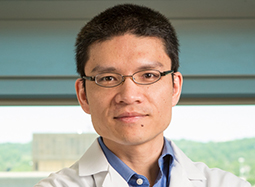Dr. Tao Yang is an assistant professor and bone disease expert in Van Andel Research Institute’s Center for Cancer and Cell Biology. He earned his Ph.D. in biochemistry from Shanghai Institute of Biochemistry and Cell Biology at the Chinese Academy of Sciences, followed by a postdoctoral fellowship at Baylor College of Medicine, Dr. Yang joined VARI in 2013. In 2017, he was awarded a prestigious grant from the Arthritis National Research Foundation and, in 2018, he was named ANRF’s Frances D. Morongo Memorial Fellow.
His work focuses in part on the underlying causes of osteoarthritis, a painful condition that affects more than 30 million people in the U.S. alone. We checked in with Dr. Yang about his work and why research into bone diseases is so vital.
The problem
Osteoarthritis (OA) is a degenerative joint disease caused by the breakdown of cartilage, an elastic tissue that serves as a biological shock absorber between bones. Without this important buffer, bones can become damaged and the surrounding tissues inflamed, resulting in swelling, stiffness and pain. OA typically worsens as time goes on (particularly if left untreated), and may eventually lead to severe pain and even loss of function.
Many factors can contribute to the loss of cartilage, including age, injury and — very commonly — genetic predisposition.
“Given the prevalence of osteoarthritis and the debilitating effects that it can have, it’s important that we find new, improved ways to treat it and improve quality of life,” Yang said. “In addition, developing new strategies to deal with OA is becoming increasingly urgent as the global population continues to grow and age, particularly as our current treatments for OA are very limited.”

Building a foundation
Before scientists can find new ways to treat OA and other bone diseases, they need to understand what’s happening behind the scenes. For Yang, that means investigating the complex web of overlapping biological pathways and factors that govern skeletal health.
“Our bones and cartilage arise from a type of cell called mesenchymal cells, which play important roles in skeletal growth, homeostasis — or balance — and repair. On the other side of the coin, problems with mesenchymal cells are some of the main causes of bone disease,” Yang explained. “By focusing on the function and life cycle of mesenchymal cells, we hope to shed new light on what keeps bone healthy versus what causes disorders like osteoarthritis.”
Beyond the bone
Like most biological pathways in the body, the ones Yang studies in relation to bone also are implicated in a host of other processes in normal health and in disease. For example, the p53 pathway is a major player in the development of cancer. Another, called sumoylation, also is important player in cell aging.
Thanks to support from the Arthritis National Research Foundation, Yang and his team will be able to continue studying these pathways using their recently developed, unique model of the disease, which allows them to study OA in a controlled way. Their hope is that the insights gleaned from these studies may one day open new avenues aimed at slowing, stopping or even reversing the disease.
“Everything in the body is connected, which means that sometimes the answers we seek are in unexpected, yet ultimately related, places,” Yang said. “With our new model, we hope to reveal more of these connections and harness our findings to impact human health.”
For more information on the Yang Lab, please visit their website here.